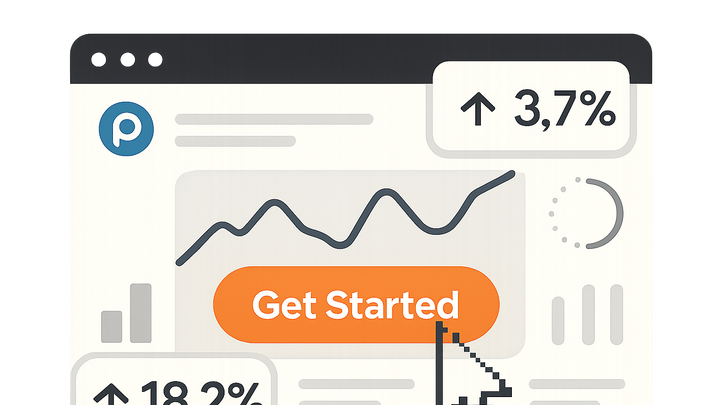Published on 2025-06-29T19:18:20Z
What is Click-Through Rate (CTR)? Examples for CRO, UX & SEO
Click-Through Rate (CTR) is a key performance metric in website optimization. It measures the percentage of users who click a specific link or call-to-action (CTA) relative to the number of views or impressions. In CRO, UX, and SEO contexts, CTR reveals how compelling your content, ads, or search snippets are to your audience. A high CTR indicates that your messaging, design, and targeting resonate well, whereas a low CTR may signal issues with headlines, CTAs, or meta tags. CTR is used across channels: organic search results, paid ads, email campaigns, and on-site CTAs. Tools like Prevue.me provide actionable critiques to help you optimize headlines, buttons, and meta descriptions to drive better CTR from visitors.
Click-through rate (ctr)
CTR measures clicks divided by impressions, reflecting how effectively links, ads, or CTAs engage users.
Understanding Click-Through Rate (CTR)
This section defines CTR, shows how it’s calculated, and explains its variations across marketing channels. Understanding the basics helps you interpret and leverage CTR in CRO, UX, and SEO strategies.
-
Definition of ctr
CTR is the percentage of users who click a specific link or CTA out of the total number of views or impressions. It’s expressed as (clicks/impressions) × 100 and provides insight into how compelling your content or ads are to your audience.
-
Calculation formula
CTR = (Number of Clicks ÷ Number of Impressions) × 100. For example, if an ad receives 50 clicks and 1,000 impressions, the CTR is (50⁄1,000)×100 = 5%. Consistent tracking ensures accurate benchmarking over time.
-
Ctr across channels
CTR varies by channel: search ads, display ads, email campaigns, and on-site CTAs each have different benchmarks. Organic search CTR depends on SERP position and snippets, while email CTR hinges on subject lines and preheaders.
- Search ads:
Typically range from 1–4% depending on industry, ranking, and ad relevance.
- Email campaigns:
Average CTR is around 2–5%, influenced by subject line, segmentation, and send time.
- Search ads:
Importance of CTR in CRO, UX, and SEO
CTR impacts conversion optimization, user experience signals, and search engine ranking. A higher CTR indicates effective design, messaging, and relevance to user intent.
-
Indicator of engagement
High CTR shows that users find your headlines, CTAs, or search snippets relevant and enticing, guiding further exploration on your site.
-
Seo signal
Search engines consider organic CTR a quality metric; pages with higher CTRs may rank higher as they align with user intent.
-
Cro and revenue impact
Improving CTR on product pages or promotional banners can directly boost conversions and revenue by funneling more users into the desired action.
Best Practices to Improve CTR
Focus on headline optimization, meta tags, design elements, and testing frameworks. Consistent experimentation and user-centric design drive incremental CTR gains.
-
Craft compelling headlines and ctas
Use clear, action-oriented language; highlight benefits; apply urgency or curiosity; personalize where possible to match user intent.
- Action verbs:
Start with strong verbs (e.g., ‘Download’, ‘Get’, ‘Discover’) to prompt immediate action.
- Benefit-focused copy:
Emphasize what the user gains (e.g., ‘Increase traffic by 30%’).
- Action verbs:
-
Optimize meta titles and descriptions
Ensure keywords are present, keep within character limits, and include a clear CTA in descriptions to improve organic search CTR.
-
Enhance ux and visual hierarchy
Improve button size, color contrast, and placement; use whitespace and directional cues like arrows or images to draw attention.
-
Leverage prevue.me for actionable critiques
Use prevue.me to receive tailored feedback on CTAs, headers, meta tags, and overall page layout to identify quick wins and A/B test ideas.
- Cro insights:
Automated critiques highlight underperforming elements and suggest improvements to increase click engagement.
- Seo and content feedback:
Get analysis on your meta descriptions, title tags, and on-page content for better SERP appeal.
- Ux and accessibility tips:
Identify design and accessibility issues that may hinder click actions, ensuring inclusive user experiences.
- Cro insights:
Common Pitfalls and How to Avoid Them
Be aware of common mistakes when focusing on CTR and balance metrics to maintain quality and trust.
-
Overemphasis on ctr alone
Focusing solely on CTR can lead to irrelevant clicks that don’t convert, inflating metrics without true ROI.
-
Misleading clickbait
Headlines that overpromise can hike CTR temporarily but damage brand trust and increase bounce rates.
-
Ignoring post-click experience
Improving CTR without optimizing landing page relevance or UX leads to high bounce and low conversions.
